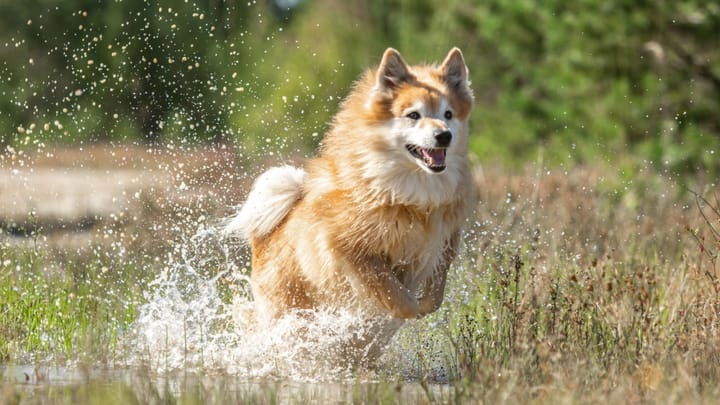Icelandic Sheepdog
Other names : Icelandic Spitz, Nordic Spitz, Iceland Dog, Islandsk Fårehund, Friaar Dog


The Icelandic Sheepdog is a type of Spitz breed that is thought to have arrived in Iceland along with the first Viking settlers. It is the island’s native breed and is used to herd sheep across the rugged Icelandic countryside. The dog is rare in other countries, but clubs and associations in the UK promote the dog’s companionable nature.
|
Life expectancy |
The Icelandic Sheepdog has a life expectancy of between 12 and 14 years |
|
Temperament |
|
|
Size |
Medium
|
|
Adult size |
Female
Between 16 and 17 in
Male
Between 17 and 19 in
|
|
Adult weight |
Female
Between 22 and 33 lb
Male
Between 22 and 33 lb
|
|
Coat colour
Seen of sable, yellow, red, and black and white. |
Black Brown Red Sand Blue |
|
Type of coat
A double coat comprising a thick, soft undercoat beneath a thick and glossy topcoat. The fur is thicker on the neck, legs and tail. |
Short Long |
|
Eye colour
Dark brown/chocolate brown |
Brown
|
|
Purchase price |
The Icelandic Sheepdog costs between £600 and £800 |
In the early 1800s, about a century after it was first imported to the UK, the breed became troublesome. Dogs that were allowed to eat the dead sheep of their flocks became infected with a type of tapeworm that they then passed to their owners. The tapeworm ‘epidemic’ destroyed three quarters of all Icelandics in the UK.
More details about the Icelandic Sheepdog
Icelandic Sheepdog: Origins and history
The canine ancestors of today’s Icelandic Sheepdog are believed to have accompanied early Viking settlers to the island of Iceland between 874 and 930 AD. It wasn’t until the early 1700s that the Icelandic Sheepdog arrived in the United Kingdom. The popularity of the dog has increased gradually since then, but the dog has never been a best-seller.
Physical characteristics of the Icelandic Sheepdog
Well-proportioned is the Icelandic Sheepdog being both long in body but tall and reasonably stocky. The head is wide and the muzzle broad and short. Ears are medium-sized and triangular with slightly rounded tips. The ears of this dog are mobile and alert, and are often telling of the dog’s mood.
FCI classification of the Icelandic Sheepdog
-
Group 5 - Spitz and primitive types
-
Section 3 : Nordic Watchdogs and Herders
Icelandic Sheepdog: Characteristics
Icelandic Sheepdog: Behaviour
Training a Icelandic Sheepdog
Training of the Icelandic Sheepdog can be challenging. It must be carried out by a confident master who is consistent and varies their style of training. Harsh training techniques will not work with any dog.
Icelandic Sheepdog: Lifestyle
Breed compatibility Icelandic Sheepdog
Icelandic Sheepdog: Purchase price
Purchasing a purebred puppy will cost anywhere from £600 to £800. Cost of care will be £130 to £180 per month.
Icelandic Sheepdog: Shedding
Average
The long, dense and furry coat of the Icelandic sheds consistently throughout the year. There is a peak of shedding in the months leading up to and throughout summer.
Icelandic Sheepdog: Grooming
This dog requires regular daily brushing to prevent its coat from becoming tangled and matted. Brushing and the occasional bath will help the coat to stay shiny and full.
Icelandic Sheepdog: Health
The Icelandic Sheepdog is generally healthy and robust. It's life expectancy is 12 years.
The Icelandic Sheepdog has been bred to work outdoors in countries within the Arctic Circle. It is a dog that seeks adventure and does not complain.
This dog does not tolerate hot weather overly well. A ‘thin and trim’ haircut will help the dog to get through the hottest time of the year.
The double coat of the Icelandic Sheepdog keeps the dog warm.
If your Icelandic is not exercised as regularly as it should be and is fed too much human or substandard food it will become obese.
- Hip dysplasia
- Progressive retinal atrophy









